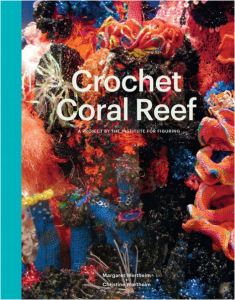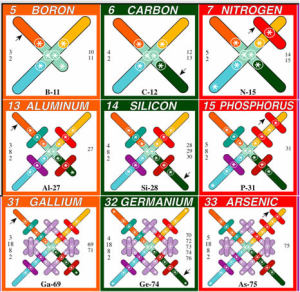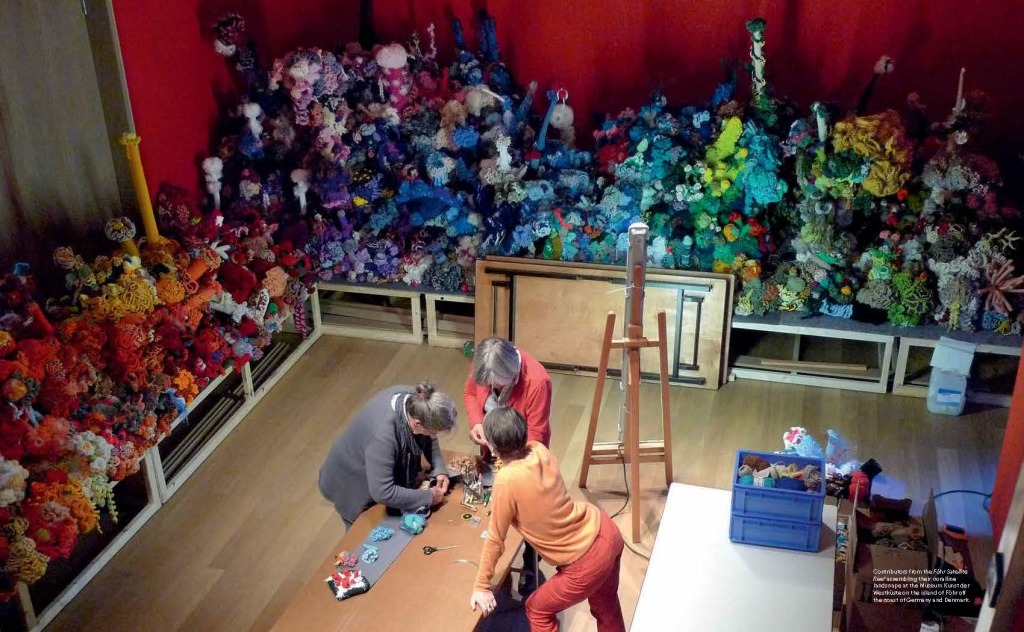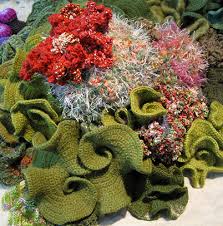The Institute For Figuring (IFF) is an organization based in Los Angeles, California that promotes the public understanding of the poetic and aesthetic dimensions of science, mathematics and the technical arts. The Institute hosts public lectures and exhibitions, publishes books and maintains a website.
Since its founding in 2003 by Margaret Wertheim and Christine Wertheim the IFF has staged public lectures and exhibitions extensively across the US, and abroad, in the UK, Europe, Asia and South Africa on subjects such as tiling patterns, hyperbolic space, early computational devices, and tensegrity structures. The Welsh writer Merrily Harpur has written that “the duty of artists everywhere is to enchant the conceptual landscape.” The IFF was founded on the principle that science, mathematics and other techno-logical pursuits may also achieve this goal.
Book
by Margaret and Christine Wertheim
Now the world’s largest participatory art and science project, the “Crochet Coral Reef” combines mathematics, marine biology, environmental consciousness raising and community art practice. Almost 8000 people around the world have helped to make these gorgeous woolen seascapes, which have been exhibited at the Hayward Gallery, the Smithsonian, and many other venues. This lavishly illustrated book, written by the project’s creators – Margaret and Christine Wertheim – brings together the scientific content behind the project along with essays about the artistic and cultural relevance of this unique experiment in radical craft practice. The book serves as a record of the 30+ Crochet Reefs worldwide and names all 7000+ contributors in a specially designed section.
Artillery – Review of Crochet Coral Reef book by Dough Harvey
Huffington Post – article on the Crochet Coral Reef as public art
Christopher Knight, LA Times – review of ‘The Loop Show’ at Beacon Arts Building
Bomb – Artists on Artists: Christine and Margaret Wertheim
A Journal of Feminist Cultural Studies – Sophia Roosth’s essay in the Crochet Coral Reef, “Evolutionary Yarns in Seahorse Valley: Living Tissues, Wooly Textiles,Theoretical Biologies”
Science Magazine – article on the Crochet Coral Reef project
The Washington Post – article on The Crochet Reef
Smithsonian Magazine – article on the Hyperbolic Crochet Coral Reef project
[ cover ]
Wired – article on The Crochet Reef
New York Times – article on The Crochet Reef
The Guardian – article on The Crochet Reef
The Times (UK) – article on Hyperbolic Crochet
Los Angeles Times – article on The Crochet Reef
X-TRA – review of Crochet Reef
Some IFF Projects and Exhibitions
THE LOGIC ALPHABET OF SHEA ZELLWEGER
Curated by IFF co-director Christine Wertheim
In 1953, while working a hotel switchboard, Shea Zellweger began a journey that would culminate in a radical new notation for formal logic, the set of relations that underlies modern computing. From a garage in Ohio, Zellweger developed a visual language he dubbed the “Logic Alphabet,” in which a group of specially designed letter-shapes are maneuvered like puzzles to reveal the geometric patterns hidden beneath the symbolic web of logic. For more than fifty years, Zellweger has been exploring the symmetries and relations inherent in these patterns, which he has made manifest in a series of delicately crafted wooden models and in thousands of pages of diagrams. In this jewel-box exhibit, the Institute For Figuring and the Museum of Jurassic Technology proudly present Dr Shea Zellweger’s Logic Alphabet models and drawings.
This exhibition was shown from March 3, 2007 to March 1, 2012 at the Museum of Jurassic Technology.
See also: Cabinet, Issue 18, Summer 2005
THE BUSINESS CARD MENGER SPONGE
by Dr Jeannine Mosely
A collaboration between the Institute For Figuring and Machine Project
Menger’s Sponge – named for its inventor Karl Menger and sometimes wrongly called Sierpinski’s Sponge – was the first three dimensional fractal that mathematicians became aware of. In 1995 Dr Jeannine Mosely, a software engineer, set out to build a Level 3 Menger Sponge from business cards. After 9 years of effort, involving hundreds of folders all over America, the Business Card Menger Sponge was completed. The resulting object is comprised of 66,048 cards folded into 8000 interlinked sub-cubes, with the entire surface paneled to reveal the Level 1 and Level 2 fractal iterations.
This exhibition was shown from August 26 – September 24, 2006 at Machine Project.
The Inaugural Exhibition at the Institute For Figuring’s new space.
What drives a man with no science training to think he can succeed where Einstein and Stephen Hawking have failed? In the Institute For Figuring’s first suite of jewel-box-like exhibitions, the main gallery will feature Physics on the Fringe, an exploration of alternative theories of the universe by geniuses, mavericks and outsiders from the nineteenth century to today. The exhibit celebrates the amateur spirit of inquiry, putting into historical context the individual impulse to understand our universe. Continuing the IFF’s commitment to participatory programming, visitors are invited to peruse our unique collection of both insider and outsider physics theories, and to write their own ideas about the structure of reality in our exhibition folio.
This exhibition was shown from April 14 – November 10, 2012 at the Institute For Figuring.
CROCHET CACTUS GARDENS
Like their living brethren, crochet cactii are found in a dazzling variety of species, with each individual crafter bringing to bear on the age-old patterns of nature unique asthetic powers. All the forms exhibited here have been inspired by the insights of “hyperbolic crochet” discovered by Cornell mathematician Dr Daina Taimina, yet each contributor has found ways to express within these algorithmic strictures their own expressive designs. In Cedar Hill, Texas, Evelyn Hardin discovered the delights of felting, using variegated soy yarns to produce undulating forms of transcendent loveliness; in Bendigo, Australia, Marianne Midelburg combed thrift stores, turning discarded wools into pebbly piles; in Culver City, Sarah Simons, a master of the floret form, concocted an entire taxonomy of cactus flowers by mixing together mercerized cottons in subtly complimentary hues. In Los Angeles Anitra Menning reigns as the queen of vegetable architectonics, crafting swooping marvels at once fuzzy and firm, while David Orozco (proprietor of That Yarn Store in Echo Park) specializes in soft flanges of green and grey, a predisposition shared by Spring Pace in the wilderness of Topanga Canyon. In Bonnie Doon in rural Australia, Helen Bernasconi, proprietress of a sheep farm, spins and dyes her own wool before painstakingly designing (with spreadsheets no less) mathematically precise clusters evoking the geometry of pincushion cactii. Although none of these forms were created to be together, to us at the IFF, they seemed destined for one another – when we came to curate this exhibition the Garden literally grew itself.
Crochet Cactus Garden , Jackson Hole, WY
The Crochet Cactus Garden, The Wignall Museum, Chaffey College
The Crochet Cactus Garden, The David Weinberg Gallery
THE CROCHET CORAL REEF
“Gorgeous, absurd, and socially productive, these are rare works of art.”
–Christopher Knight, Los Angeles Times
In 2005 the IFF began to crochet a coral reef. Today more than 7000 people have joined in creating this ever-growing plastic and woolly wonder. More than 25 Crochet Reefs have been made around the world – in New York, Chicago, London, Melbourne, Oslo, Arizona, Indiana, Ireland, Germany, Latvia and elsewhere.
This vast handmade archipelago – resulting from more than 200,000 hours of human labor – is one of the most extensive community artworks ever. Collections of Crochet Reefs have been shown at major art galleries and science museums worldwide, including the Chicago Cultural Center, the Hayward Gallery (London), Science Gallery (Dublin) and the Smithsonian’s National Museum of Natural History (Washington DC).
“Hooray for all the work, play, thought, and precious bodily fluids that went into making this ongoing art!”
–Donna Haraway, Science + Technology Studies Scholar, UC Santa Cruz
“The AIDS Quilt of global warming.”
— Lawrence Weschler, New York Institute for the Humanities
Interview with Margaret and Christine Wertheim about the Reef project – in The Believer
RECENT EXHIBITIONS
- Leonardo da Vinci, the Codex Leicester, and the Creative Mind, Minneapolis Institute of Arts
- Night Begins the Day, Contemporary Jewish Museum, San Francisco
- Crochet Coral Reef, Southwest School Of Art, San Antonio, Texas
- Crochet Coral Reef, New York University, Abu Dhabi Institute, UAE
- Hyperbolic: Reefs, Rubbish, and Reason, Art Center College of Design, Pasadena, California
- The Hyperbolic Crochet Coral Reef, Sant Ocean Hall, Smithsonian, Washington, D.C.
Helpful things to have in order to crochet a coral reef:
Knowledge of non-euclidean geometry
Interest in embodied forms of reasoning
A global sewing bee of serious science communication
Some Recent Plastic Reefs
Other Reef Images
















